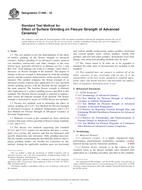We need your consent to use the individual data so that you can see information about your interests, among other things. Click "OK" to give your consent.
ASTM C1495-16
Standard Test Method for Effect of Surface Grinding on Flexure Strength of Advanced Ceramics
Translate name
STANDARD published on 1.9.2016
The information about the standard:
Designation standards: ASTM C1495-16
Note: WITHDRAWN
Publication date standards: 1.9.2016
SKU: NS-653081
The number of pages: 12
Approximate weight : 36 g (0.08 lbs)
Country: American technical standard
Category: Technical standards ASTM
The category - similar standards:
Annotation of standard text ASTM C1495-16 :
Keywords:
advanced ceramic, baseline flexure strength, damage tolerance, flexure strength, machining, surface grinding,, ICS Number Code 81.060.30 (Advanced ceramics)
Additional information
| Significance and Use | ||||||||||||
|
5.1 Surface grinding can cause a significant decrease1.1 This test method covers the determination of the effect of surface grinding on the flexure strength of advanced ceramics. Surface grinding of an advanced ceramic material can introduce microcracks and other changes in the near surface layer, generally referred to as damage (see Fig. 1 and Ref. (1)).2 Such damage can result in a change—most often a decrease—in flexure strength of the material. The degree of change in flexure strength is determined by both the grinding process and the response characteristics of the specific ceramic material. This method compares the flexure strength of an advanced ceramic material after application of a user-specified surface grinding process with the baseline flexure strength of the same material. The baseline flexure strength is obtained after application of a surface grinding process specified in this standard. The baseline flexure strength is expected to approximate closely the inherent strength of the material. The flexure strength is measured by means of ASTM flexure test methods. 1.2 Flexure test methods used to determine the effect of surface grinding are C1161 Test Method for Flexure Strength of Advanced Ceramics at Ambient Temperatures and C1211 Test Method for Flexure Strength of Advanced Ceramics at Elevated Temperatures. 1.3 Materials covered in this standard are those advanced ceramics that meet criteria specified in flexure testing standards C1161 and C1211. 1.4 The flexure test methods supporting this standard (C1161 and C1211) require test specimens that have a rectangular cross section, flat surfaces, and that are fabricated with specific dimensions and tolerances. Only grinding processes that are capable of generating the specified flat surfaces, that is, planar grinding modes, are suitable for evaluation by this method. Among the applicable machine types are horizontal and vertical spindle reciprocating surface grinders, horizontal and vertical spindle rotary surface grinders, double disk grinders, and tool-and-cutter grinders. Incremental cross-feed, plunge, and creep-feed grinding methods may be used. 1.5 The values stated in SI units are to be regarded as standard. No other units of measurement are included in this standard. 1.6 This standard does not purport to address all of the safety concerns, if any, associated with its use. It is the responsibility of the user of this standard to establish appropriate safety and health practices and determine the applicability of regulatory limitations prior to use. |
||||||||||||
| 2. Referenced Documents | ||||||||||||
|
We recommend:
Technical standards updating
Do you want to make sure you use only the valid technical standards?
We can offer you a solution which will provide you a monthly overview concerning the updating of standards which you use.
Would you like to know more? Look at this page.




 Cookies
Cookies
